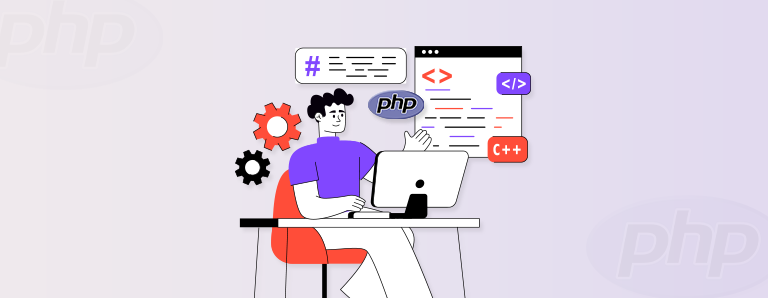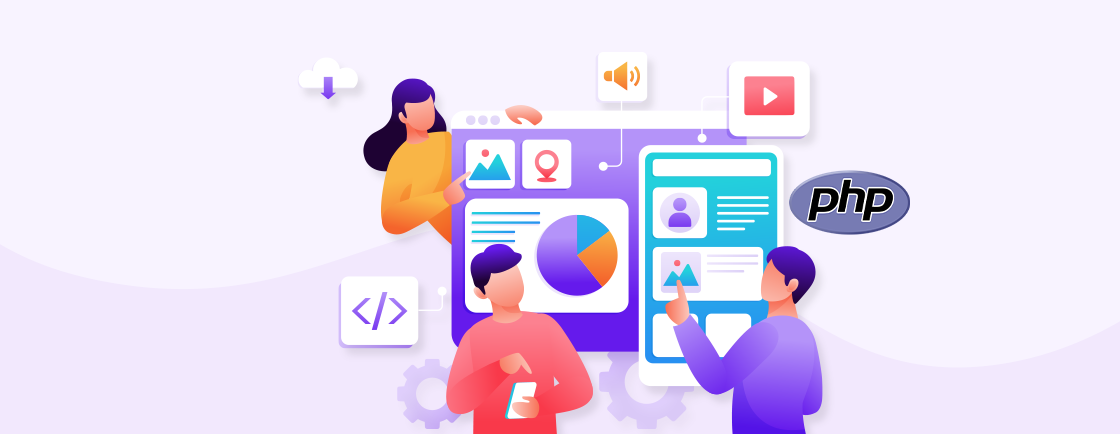Table of Contents
Robotics is one of the most rapidly-evolving industries. So there’s a constant need for new skills and technologies for creating ultra-advanced robots.
Traditional robotics projects are swamped by popular programming languages like C++ and Python. But PHP can be a valuable tool in specific aspects of robotics development and application. Why, though? Why is PHP getting traction in the field of robotics? And what kind of applications can it help with?
Our experts have helped me create this blog explaining the “Why” and “How” of using PHP in robotics. Let’s begin.
Why Use PHP in Robotics?
As I mentioned earlier, there are several languages, like C++ and Python, that dominate traditional robot controls. But still, there are some special situations where PHP might be a preferable choice. Here are a few reasons to use PHP in robotics.
Existing Web Development Expertise
Experts already have the expertise with the advanced PHP concepts. So leveraging them for web-based aspects of your robotics project can be advantageous. Utilizing existing expertise reduces the learning curve. So the development process is more streamlined compared to learning a completely new language solely for the web interface.
Rapid Prototyping and Web-based Functionalities
PHP is easy to use and has rapid development capabilities. So it will be ideal for quickly building web interfaces and functionalities for controlling or monitoring robots. You can also create prototypes and test initial concepts before diving into more complex. Go for low-level programming for core robot control.
Cost-effectiveness
PHP is an open-source language. So it’s free to use and comes with a large, active community for support. This can be a significant advantage for projects with limited budgets. And some proprietary robotics programming languages come with license fees. With PHP, you can avoid them.
Integration with Existing Web Infrastructure
Does your robotics project need to interact with existing web services or platforms? Then PHP’s seamless integration with web technologies like databases and APIs can simplify the development process. It allows for smooth data exchange and communication between the robot and other web-based systems.
Educational and research purposes
PHP ensures accessibility and relative ease of learning. So it can be a suitable choice for educational or research projects involving robotics. Students and researchers can focus on core concepts and algorithms with ease. They don’t get bogged down in the intricacies of lower-level programming languages.
You need to understand that PHP can’t be and shouldn’t be used in robotic projects on its own. It excels in specific areas like web interfaces, data management, and communication.
But for real-time control and low-level operations, popular programming languages like C++ and Python will be better suited. Their performance and hardware access capabilities would be helpful. If your robotics project needs powerful web interfaces or seamless data integration, collaborate with a PHP development company that delivers tailored, cost-effective solutions.
What are the Applications of PHP in Robotics?
While not ideal for core robot control, PHP holds value in specific aspects of robotics. That’s because of its strengths in web development and server-side scripting. Here’s where PHP shines.
- Remote Control Interfaces: Build web interfaces for users to control robots remotely via a web browser. Applications include sending commands, receiving sensor data, and monitoring performance in real-time.
- Data Visualization & Logging: Process and display sensor data in user-friendly formats for analysis, debugging, performance evaluation, and training purposes.
- Robot Status Dashboards: Create dynamic dashboards displaying essential information like battery level, location, and task completion.
- API Development: Build APIs enabling interaction between robots and other applications/systems. It facilitates functionalities like external service integration, cloud platform data sharing, and communication with other robots.
- Database Management: Manage databases storing robot data like sensor readings, configuration settings, and log files. That allows for efficient access, analysis, and manipulation of information.
- Simulations & Virtual Environments: Develop web-based simulations and virtual environments for educational purposes. It allows for safe and controlled experimentation with robot behaviors and algorithms.
- Data Analysis & Machine Learning: While not directly controlling robots, PHP can analyze collected data and train machine learning models. It will help improve robot performance, decision-making, and overall functionality.
Remember, PHP isn’t typically used for real-time, low-level robot control tasks. That is because of its limitations in performance and hardware access.
How to Use PHP in Robotics?
While not a core language for robot control, PHP can be integrated into your robotics project through specific steps:
Define Your Project Scope
Clearly identify the functionalities you want to achieve with PHP. Will it be a web interface, data management tool, or API development?
Determine the interaction points between PHP and other components in your project. This could involve connecting to robot control systems, databases, or external services.
Set Up Your Development Environment
Install a web server like Apache or Nginx on your system to run your PHP scripts.
Configure PHP on your server, ensuring it has necessary extensions and libraries for your project’s requirements.
Choose a suitable code editor or IDE (Integrated Development Environment) for writing and managing your PHP code.
Develop Your PHP Application
Start by writing the core functionalities of your application. This might involve creating web pages for user interaction, building APIs for communication, or developing scripts for data processing and visualization.
Utilize relevant PHP libraries and frameworks to simplify development and access specialized functionalities. Popular choices include Laravel, Symfony, and CodeIgniter.
Implement security measures to protect your application from potential vulnerabilities, especially if it involves user input or sensitive data.
Integration and Testing
Integrate your PHP application with other components of your robotics project. This could involve connecting to robot control systems, databases, or external services using appropriate APIs or protocols.
Thoroughly test your application to ensure it functions as expected, handles errors gracefully, and delivers the desired results. This includes testing different user inputs, edge cases, and potential failure scenarios. Make use of the PHP testing frameworks like PHPUnit and ensure everything works as intended.
Deployment and Maintenance
Deploy your application to a suitable hosting environment. Make it accessible to users or integrated with your robotics system.
Regularly maintain your application by fixing bugs and implementing updates. Try to address the security concerns as needed. So the users have the best possible experience with the application at all times.
Familiarize yourself with relevant robotics concepts and technologies. So you have the best understanding of how your PHP application interacts with the broader system.
As with anything, with benefits, come the limitations. These include performance limitations for real-time control tasks.
What Kind of Robots can be Programmed with PHP?
PHP can be used in conjunction with various types of robots. But it’s important to understand that PHP itself doesn’t directly control robot movement or actions. Its strengths lie in web development and server-side scripting. So it’s suitable for specific aspects of robot functionality, not core control.
Industrial Robots
Due to the real-time, performance-critical nature of industrial robot operations, PHP wouldn’t be used for core control tasks like movement or sensor data processing. These tasks are typically handled by languages like C++ or Python. Their low-level access and performance advantages are helpful.
For the industrial robots, PHP can be used for web-based monitoring dashboards. They can help display robot status, performance metrics, and error logs. You can also use PHP for communication between the robots and external systems. It can also help with data exchange or integration with other industrial machinery.
Autonomous Robots
Again, PHP wouldn’t directly control core autonomous functionalities like navigation, obstacle avoidance, or decision-making. These tasks often require real-time processing and hardware interaction. Languages like C++ and python will be better suited.
For autonomous robots, PHP can be used for web interfaces for remote monitoring. So you can control the robot’s mission parameters or data visualization. And you can develop APIs for data exchange with cloud platforms for storing sensor data. Plus, it can help enable communication with other robots.
Educational Robots
For educational robots, real-time performance is not as critical. So PHP can be used for broader functionalities. You can build web-based user interfaces for students to interact with the robot, send commands, and receive sensor data.
PHP can help develop simulations and virtual environments for educational purposes. So students can experiment with robot behavior and programming concepts in a safe and controlled setting.
And PHP can be used for managing databases. You can store sensor readings, experiment results, or student progress data.
When choosing the right tool for the job, you have to consider the specific functionalities and technical requirements. While PHP offers valuable functionalities in specific areas, you will need other languages and platforms as well. That way, you will be able to handle real-time control and low-level hardware interaction for comprehensive robot programming.
If your robotics project needs custom web dashboards, remote monitoring tools, or API integrations, you should hire dedicated PHP developers to deliver secure, scalable, and tailored solutions for your robotic systems.
Conclusion
The world of robotics is rapidly advancing. It demands diverse skill sets to create and manage these complex systems. Languages like C++ and Python and platforms based on them dominate the robotics field. But there is a surprising new contender: PHP.
Although it can’t create and control the robots independently, you can use it for some critical functionalities. Like, web-based interfaces for the robots and effective communication and data management. It can help with rapid prototyping and integration with existing web infrastructure in a cost-effective manner.
And if you need help with robotics or other advanced projects, you can consult with our experts!
FAQs on Using PHP for Robotics
Is PHP a good language for robot programming?
PHP is not a traditional core language for robot control due to performance limitations. But it can be valuable for specific aspects of robotics projects. Its strengths lie in web development and server-side scripting. So you can use it for web-based interfaces, communication and data management, etc.
When would I choose PHP for a robotics project?
Consider using PHP when:
– Your project requires functionalities like web interfaces, data management, or API development.
– You have existing expertise in PHP and want to leverage your team’s skills.
– You are building an educational robot or working on a research project where real-time performance is not critical.
What are the limitations of using PHP for robotics?
– Not suitable for real-time control: PHP is not optimized for real-time performance and precise timing needed for core robot control tasks.
– Limited hardware access: PHP has limitations in directly interacting with robot hardware compared to languages like C++.
Master PHP Web Development
Access expert guides and tips to enhance your PHP programming capabilities.





